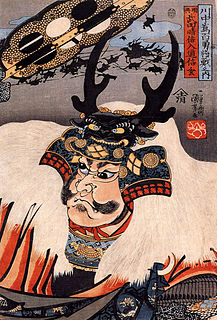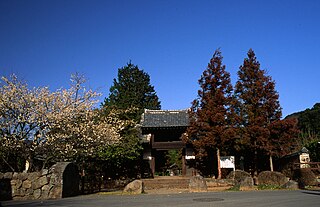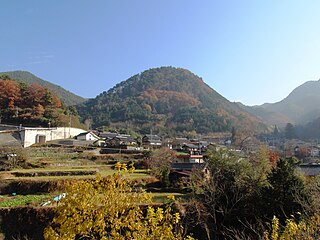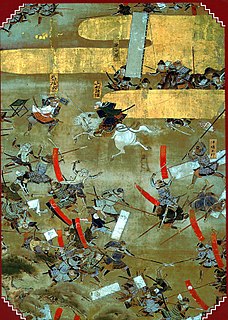
Takeda Shingen, of Kai Province, was a pre-eminent daimyō in feudal Japan with exceptional military prestige in the late stage of the Sengoku period.

Tenbun (天文), also known as Temmon, was a Japanese era name after Kyōroku and before Kōji. This period spanned from July 1532 through October 1555. The reigning emperor was Go-Nara-tennō (後奈良天皇).

Itagaki Nobukata was a retainer of the Takeda family. His name is also seen with different kanji as 信形.

Takeda Nobutora was a Japanese daimyō who controlled the Province of Kai, and fought in a number of battles of the Sengoku period.
Takeda Nobukado was a Japanese samurai warrior of the Sengoku period. He was known as one of the "Twenty-Four Generals of Takeda Shingen".

Takeda Nobushige was a samurai of Japan's Sengoku period, and younger brother of Takeda Shingen. Takeda Nobushige held the favor of their father, and was meant to inherit the Takeda lands, wealth and power, becoming head of the clan. However, Shingen rebelled against their father and seized the lands and power for himself.
The Battle of Un no Kuchi (海ノ口城の合戦) in 1536 was the first major victory for Takeda Harunobu, aged fifteen at the time. He would later take on the name Takeda Shingen, and grow to become one of Japan's most famous warlords.
Amari Torayasu was a Japanese samurai of the Sengoku period, and served the Takeda clan under Takeda Nobutora and Shingen. Amari was a shukurō, or clan elder, following Shingen's accession to family headship and was one of "Twenty-Four Generals of Takeda Shingen". He was killed in action at the battle of Uedahara in 1548, together with Itagaki Nobukata. The two were fighting side by side on the frontlines when suddenly a volley of arrows shot them down.
Naitō Masatoyo also known as Naitō Masahide was a Japanese samurai of the Sengoku period. He was known as one of the "Twenty-Four Generals of Takeda Shingen". Masatoyo was the second son of Takeda Nobutora's senior retainer, Kudō Toratoyo. He was first called Kudō Sukenaga. The family's fortunes fell when Toratoyo lost favor with Nobutora and was killed by him.
Suwa Yorishige (諏訪頼重) (1516–1544) was a Japanese samurai and head of the Suwa clan. He was defeated by Takeda Shingen, and his daughter Suwa Goryōnin was taken as Shingen's concubine. She later gave birth to the Takeda clan heir Takeda Katsuyori.
Tada Mitsuyori was a Japanese samurai of the Sengoku period. He is known as one of the "Twenty-Four Generals of Takeda Shingen".
The 1526 battle of Nashinokidaira (梨の木平の戦い) was one of many battles fought between the Takeda and Hōjō clans in Japan's Sengoku period. On 8 July of that year, the battle was won by Takeda Nobutora over Hōjō Ujitsuna.
Fūrin Kazan (風林火山) was the 46th NHK Taiga drama television series beginning on January 7, 2007. It was aired throughout 2007.
Anayama Nobutomo was a Japanese samurai of the Sengoku period. He was the son of Anayama Nobutsuna. Nobutomo served the Takeda clan of Kai Province and held the title of Izu-no-kami (伊豆守), or Defender of Izu. He enjoyed special status in the Takeda retainer band due to his marriage to Takeda Nobutora's daughter. Nobutomo fought with distinction during the attack on Suwa Yorishige in 1542. After his death on New Year's Day 1561, he was succeeded by his son Anayama Nobukimi.
Ichijō Nobutatsu was a Japanese samurai of the Sengoku period, who was the younger brother of Takeda Shingen, the ruler of Kai Province. He is known as one of the "Twenty-Four Generals of Takeda Shingen". Nobutomo also served under Shingen's son, Takeda Katsuyori.
Imagawa Ujichika was a Japanese daimyō of the Sengoku period. He was the 10th head of the Imagawa clan of Suruga Province.

Yōgaiyama Castle was a Sengoku period yamajiro located in Kai Province, constructed in the 1520s by the Takeda clan. Since 1991, its site has been proclaimed a National Historic Site by the Japanese government.
Takeda Shingen (武田信玄) is a 1988 Japanese television series. It is the 26th NHK Taiga drama.








